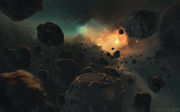|
|
| Line 120: |
Line 120: |
| *'''Composition:''' Terrestrial | | *'''Composition:''' Terrestrial |
|
| |
|
| [[Daleem]] is a small terrestrial planet in the Nilgaard sector of the Outer Rim territories under the rule of the [[Vatali Empire]]. It current serves as the primary base of operations of House [[Satele Shan]] and the [[Sentinel Network]]. The upper atmosphere of Daleem is plagued with random severe electrical storms that wreak havoc upon the electrical systems of any ship which is unfortunate enough to get caught in one. These storms last usually around a week but have been known to last up to a month. The storms appear randomly but are easily predicted with up to a few hours warning. The storms only affect the upper atmosphere and do not affect life on the ground or in the ocean. | | [[Daleem]] is a small terrestrial planet in the Nilgaard sector of the Outer Rim territories under the rule of the [[Vatali Empire]]. It served as the primary base of operations of the now disbanded House [[Satele Shan]] and the [[Sentinel Network]]. The upper atmosphere of Daleem is plagued with random severe electrical storms that wreak havoc upon the electrical systems of any ship which is unfortunate enough to get caught in one. These storms last usually around a week but have been known to last up to a month. The storms appear randomly but are easily predicted with up to a few hours warning. The storms only affect the upper atmosphere and do not affect life on the ground or in the ocean. |
|
| |
|
| ==Solyiat== | | ==Solyiat== |
| Line 134: |
Line 134: |
| *'''Composition:''' Terrestrial | | *'''Composition:''' Terrestrial |
|
| |
|
| Solyiat is a colder planet and the headquarters of [[House Hoth|JTF Hoth]]. It holds eight continents with various islands throughout, with only 10% of that currently populated. Due to the rich mineral deposits in the southern, and formerly northern, pole, the planet has become a prime location for the mining of resources. | | Solyiat is a colder planet and was the headquarters of the now defunct [[House Hoth|JTF Hoth]]. It holds eight continents with various islands throughout, with only 10% of that currently populated. Due to the rich mineral deposits in the southern, and formerly northern, pole, the planet has become a prime location for the mining of resources. |
|
| |
|
| ==Defences and Accessibility== | | ==Defences and Accessibility== |
The Kiast system is situated in the Nilgaard sector in the Outer Rim Territories. It is located somewhere within the Palioxis Cloud nebula in an isolated part of the sector, branching off from the Perlemian Trade Route.
It is the home system of Odan-Urr and the Vatali Empire, and was the headquarters of the Jedi resistance against the Dark Council. Following the general dissolution of that group and integration of Odan-Urr into the larger Empire, it has served as a contested territory between the Vatali Empire and the Vauzem Dominion.
Binary Stars
 Kiast, from Kaerls
Kiast, from Kaerls
Kiast is a binary star system, containing two suns orbiting around each other. The smaller, Kiast Besh, orbits around its larger twin, Kiast Aurek. Aurek is a G-class star in its prime, glowing bright yellow and hot, providing Kiast and the outlying planets with plentiful warmth and energy for growth.
Besh is a B-class star, a red draw formed from leftover material that Aurek failed to pull in upon its creation. Orbiting at a fair distance from its twin, Besh is the star closest to Kiast, and while its heat is far less apparent than its twin’s, its gravitational pull has a very strong influence on Kiast’s tectonic activity. It has a very stable orbit, affecting the main planet only during the summer months, when it’s closest to it.
Orbits
Quelor
 Quelor orbits close to its star
Quelor orbits close to its star
- Distance from the Sun: 33 mil. km
- Diameter: 4,420 km
- Revolution period: 32 standard days
- Rotation period: 35 standard days
- Moons: Ka
- Atmosphere: None
- Temperature: Quelor’s surface temperatures range from 988 degrees to -270 degrees Standard.
- Composition: Rocky planet
Quelor is a dead rock formed too close to the binary star. It is constantly scorched by extreme temperatures, turning its surface into a desolate, hot and arid wasteland. The planet has a very thin meridian between the day and night sides where massive energies soar and temperature differentials wreak havoc on the environment, creating explosive geysers and volcanoes of frozen rock and ice.
Quelor’s rotation period is several days shorter than its revolution period, and the temperature conversion is slow and often very violent. However, despite the activity, Quelor has absolutely no atmosphere and only minimal gravity. Its one solitary moon is no better off as its revolutionary period around Quelor brings it near the binary star’s corona, annihilating anything and everything on its surface. Ka is, in essence, a very large crystallized rock formed from billions of years of extreme temperatures from its parent star.
Sorilis
 Sorilis, the giant
Sorilis, the giant
- Distance from the Sun: 120 mil. km
- Diameter: 42,412 km
- Revolution period: 212 Standard Days
- Rotation period: 32 Standard Hours
- Moons:
- Atmosphere: Type IV
- Temperature: -55˚C to -115˚C
- Composition: Gas Giant
Sorilis is a gas giant composed of hydrogen with a quarter of its mass being helium, though helium comprises only about a tenth of the number of molecules. It may also have a rocky core of heavier elements, but like the other giant planets, Sorilis lacks a well-defined solid surface. Clouds of ammonia crystals perpetually cover its surface, arranged into bands of different latitudes known as tropical regions. The interactions of these bands and zones create turbulence and storms. Thin clouds of water underlying the ammonia layer are known to cause lightning storms in the atmosphere of Sorilis.
Kiast
- Main article: Kiast (Planet)
 Kiast, the Capital
Kiast, the Capital
- Distance from the Sun: 88 mil. km
- Diameter: 14.432 km
- Revolution period: 426 Standard Days
- Rotation period: 24.2 Standard Hours
- Moons:
- Kaerls ice moon
- 6 other satellites
- Atmosphere: Type I/Type IV
- Temperature: 205˚C(surface level) to 25˚C
- Composition: Terrestrial
Kiast is a terrestrial world uniquely formed to hold both type I and type IV atmospheres. Its surface is covered in a thick concoction of toxic gases heavier than air which makes its surface uninhabitable to most of the galactic species. Above the cloud cover, however, life blooms in large hovering cities and space stations, starships and airships. It is the home of Clan Odan-Urr and their base of operations to fight the Sith menace and the Dark Brotherhood.
Kiast is the Capital of the Vatali Empire and their main source of tibanna gas exports. The Vatali colonized Kiast several hundred years before the Galactic Empire and severed ties with their home system to create a sovereign system.
Kaerls ice moon
- Main article: Kaerls
 Kaerls, the unforgiving
Kaerls, the unforgiving
- Diameter: 5.897 km
- Revolution period: 335 Standard Days
- Rotation period: 23.6 Standard Hours
- Atmosphere: Type I
- Temperature: -35˚C to -67˚C
- Composition: Terrestrial
The Kaerls ice moon is one of the worlds orbiting Kiast. It is the farthest away from its homeworld and has a fairly low revolutionary period, keeping in the dark side of the planet for most of the year. As such the moon has formed a world-spanning winter that freezes completely during the winter months, while thawing only around the equator during the summer, revealing only a very thin belt of irrigable land.
The world has no sentient inhabitants, save for the colony inhabited by the Okami Mandalorians who govern the world in the name of the Vatali Empress. The Mandalorians govern and protect the vast ice mining diggers that collect, refine and transport drinkable water off-world to the rest of the Empire.
Daleem
- Main article: Daleem
- Distance from the Sun: 70 MIL KM
- Diameter: 9500KM
- Revolution period: 380 Days
- Rotation period: 34 Hours
- Moons: none
- Atmosphere: Type I
- Temperature: 64˚C to -80˚C
- Composition: Terrestrial
Daleem is a small terrestrial planet in the Nilgaard sector of the Outer Rim territories under the rule of the Vatali Empire. It served as the primary base of operations of the now disbanded House Satele Shan and the Sentinel Network. The upper atmosphere of Daleem is plagued with random severe electrical storms that wreak havoc upon the electrical systems of any ship which is unfortunate enough to get caught in one. These storms last usually around a week but have been known to last up to a month. The storms appear randomly but are easily predicted with up to a few hours warning. The storms only affect the upper atmosphere and do not affect life on the ground or in the ocean.
Solyiat
- Main article: Solyiat
- Distance from the Sun: 60 MIL KM
- Diameter: 9700KM
- Revolution period: 358 Days
- Rotation period: 32 Hours
- Moons: none
- Atmosphere: Type I
- Temperature: -60C to 23.33C
- Composition: Terrestrial
Solyiat is a colder planet and was the headquarters of the now defunct JTF Hoth. It holds eight continents with various islands throughout, with only 10% of that currently populated. Due to the rich mineral deposits in the southern, and formerly northern, pole, the planet has become a prime location for the mining of resources.
Defences and Accessibility
 The Palioxis Cloud asteroid field
The Palioxis Cloud asteroid field
Because of its location inside the Palioxis Cloud nebula alongside the Perlemian Trade Route, the Kiast system has been regarded as being a "fortress system." The surrounding nebula is filled with countless asteroid fields, inaccessible to those without the routes through the asteroid fields. Passages through the asteroid fields are created at intervals in which particular sections of the fields drift apart, allowing for those with the navigational charts detailing when and where these passages form to pass through unharmed. However, the navigational charts are useless to outsiders, given that the charts need to be updated on a regular basis as asteroid patterns shift, which are monitored from observation outposts within the nebula outfitted with specialized tools and scientists.
Even with the Vatali's meager navy, a full-scale assault on the system would be suicide. The precise timing of the passages makes maneuvering fleets a burdensome process that might not allow for larger vessels to pass through unscathed. Even less plausible, would be an invading force's ability to arrange fleets in formations through the nebula; in some cases, ships might have to navigate independently. In the event of an actual strike, the Vatali navy is equipped with vessels that favour maneuverability above all else, allowing them to arrange inside asteroid fields for protection against opposing forces. A number of these fields are also home to pirate factions that might see invading fleets as trespassers. Among these outlaws, unorthodox tactics such as rigging asteroids to explode are not uncommon and could mean the demise of a sizable force caught unawares.
The Kiast system's front line of defence, however, rests in the fact that it is undetectable. Odan-Urr's assistance in 34 ABY removed the system's position from star charts; initially, to mask its presence from the First Order. This act has coincidentally, sheltered the system from the Brotherhood's knowledge bases. Later assistance severed the First Order's connection to Kiast's navigational charts, leaving the Vatali Empire with the sole access to them. It is, however, unlikely that the Brotherhood would ever risk sending a military force along a route as well-defended as the Perlemian Trade Route outside of its borders. Most worlds along the trading route are well-known and possess their own defences that would act as a deterrent when threatened.
Vatali escorts serve as the primary means of transport through the ever-changing maze of asteroid fields in the nebula. Serving as a trading hub connected with the Perlemian Trade Route, Palioxis Station also serves as the gateway to the Kiast system. Vatali escorts make their connection here to the system's worlds, bringing travellers and traders through the asteroid fields using their navicomputers linked to the Vatali's navigational charts. This is done either through allowing passengers onto the escort's vessels, or slaving other ships' navigations to the escort.
A recent change saw this defense breached following a push by pirates to enter Vatali space from an untested vector. Attempting to brute-force their way through the cloud and relying upon heavy armour plating to protect them, the vessel was destroyed following a collision with several asteroids. The gigantic explosion which resulted from this left an opening within the cloud which, while still extremely hazardous, would allow for smaller ships to enter and exit the region. In response to this, the newly formed House Sunrider was tasked with protecting this new gap and combatting the rising level of piracy which had emerged thanks to this weakness.